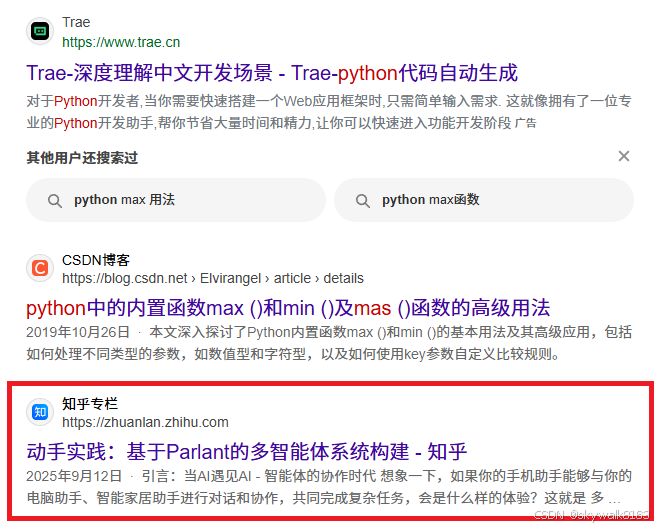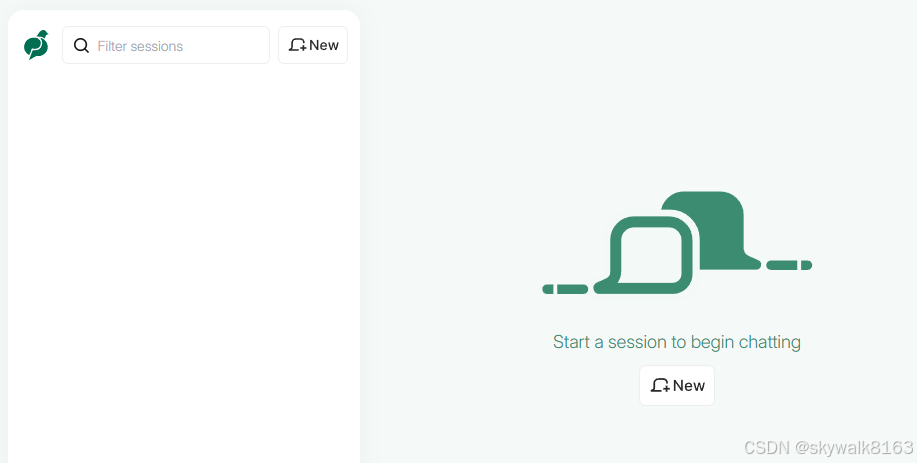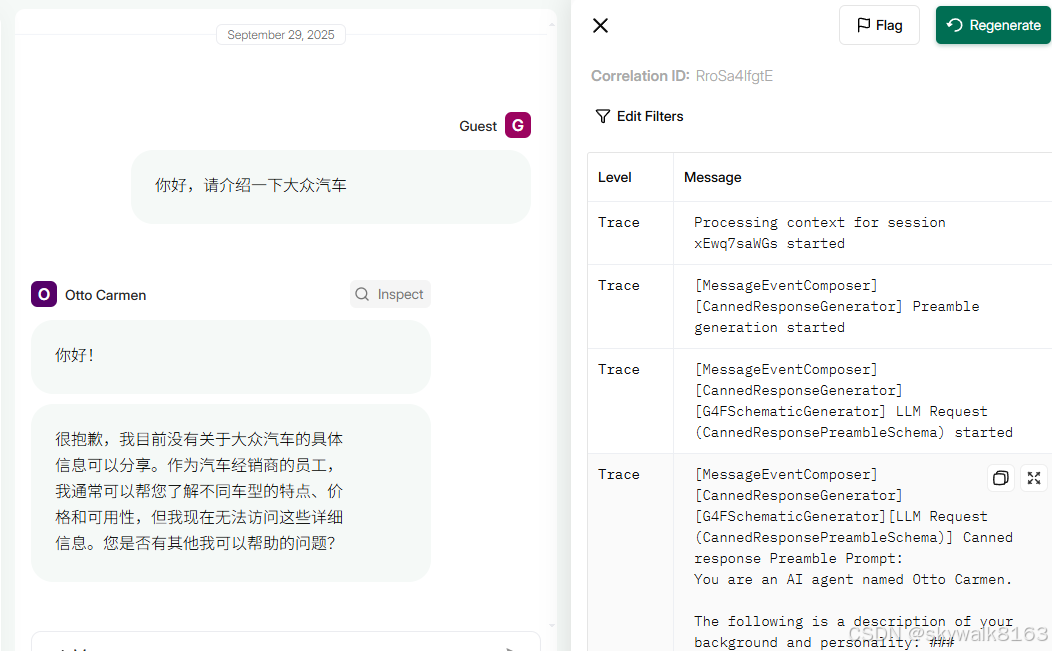能够真正遵循指令的LLM智能体parlant(个人比较看好它)
Parlant是一个开源的LLM代理行为建模引擎,可帮助开发者快速创建可控、清晰的对话代理。它支持多代理协同工作,允许不同部门独立维护专属智能体。与依赖提示工程的传统方法不同,Parlant通过规则定义确保行为一致性,60秒即可启动智能体。安装简单,支持OpenAI接口,需配置API_KEY和模型名称。开发者评价其优雅实用,适合构建业务对话系统。目前提供Python SDK和Web界面,文档详细但
Parlant 是一个用于LLM agent的开源代理行为建模引擎,旨在帮助开发人员创建具有控制力、清晰度和信心的客户参与、业务一致的对话代理。
官网:github.com
镜像:parlant: Parlant 是一个用于 LLM agent 的开源代理行为建模引擎,旨在帮助开发人员快速创建具有控制力、清晰度和信心的客户参与、业务一致的对话代理
中文手册:https://www.zdoc.app/zh/emcie-co/parlant
怎么找到的Parlant
我在搜索“哪里有好的多agent协同工作的框架?”时,并没有看到parlant,但是AI列出的框架里面有Python-MAS,于是用bing搜索“Python-MAS” ,发现第三个推荐页面,就是parlant,而且第一个和第二个跟多agent框架无关:

然后通过这篇介绍文章,找到了parlant 。后面看parlant的说明书,发现它确实有些比较特别的东西,非常值得学习和使用!
文档说:60 秒内启动您的智能体
这真的很吸引人!
每个智能体均可通过独特配置实现风格、仪态和交互模式的定制化,精准契合目标用户需求。更重要的是,不同业务单元可以独立拥有并维护专属智能体。例如:
- IT 部门管理 Hexon
- 客户成功团队负责 Sprocket
- 销售/市场部门掌控 Piston
这种基于智能体的设计为 Parlant 内部关注点分离创造了天然边界
开发者为何选择 Parlant
🏗️ 传统 AI 框架 |
⚡ Parlant |
|
|
解决方案:停止与提示词博弈,转而传授原则
Parlant彻底颠覆了AI智能体的开发模式。与其寄望于大语言模型会遵循指令,Parlant能确保它必定遵循。
# Traditional approach: Cross your fingers 🤞
system_prompt = "You are a helpful assistant. Please follow these 47 rules..."
# Parlant approach: Ensured compliance ✅
await agent.create_guideline(
condition="Customer asks about refunds",
action="Check order status first to see if eligible",
tools=[check_order_status],
)🌟 开发者评价
"这是我迄今为止遇到过的最优雅的对话式 AI 框架!使用 Parlant 进行开发是一种纯粹的享受。" — Vishal Ahuja,摩根大通客户对话 AI 高级主管
实践
安装Parlant
pip install parlant创建第一个智能体
环境变量加上:
export OPENAI_API_KEY=hello
export OPENAI_BASE_URL=http://192.168.1.5:1337/
export MODEL_NAME = "default"执行下面python代码:
import asyncio
import parlant.sdk as p
async def main():
async with p.Server() as server:
agent = await server.create_agent(
name="Otto Carmen",
description="You work at a car dealership",
)
asyncio.run(main())运行后服务启动:
2025-09-25T14:35:29.933741Z [info ] [<main>] Parlant server version 3.0.2
2025-09-25T14:35:29.934211Z [info ] [<main>] Using home directory '/home/skywalk/github/parlant-data'
2025-09-25T14:35:29.937969Z [info ] [<main>] No external modules selected
2025-09-25T14:35:30.578504Z [info ] [<main>] Initialized OpenAIService
..
:=++++=-
:+***+++**+.
.=*****++++*+=:.
.=+++*******-
..:::::... .::::=++
.-+***#####**+=-..=+=:.
:+######***********. =***=.
=####**###**********+ .*****-
=#******###** v3.0 **+ .******-
:#*******#######****=. =********:
.*#******#*:---=-::..-*********+
-##*##***. -----=++*******++**:
:*###**: =****###**********+:
-+*#- -****************+-
.: .*******++++++==-.
.****+=:.
=+=:.
..
Caching entity embeddings (1) ━━━━━━━━━━━━━━━━━━━━━━━━━━━━━━━━━━━━━━━━ 0:00:00
2025-09-25T14:37:18.053789Z [info ] [<main>] .-----------------------------------------.
2025-09-25T14:37:18.054136Z [info ] [<main>] | Server is ready for some serious action |
2025-09-25T14:37:18.054627Z [info ] [<main>] '-----------------------------------------'
2025-09-25T14:37:18.054756Z [info ] [<main>] Server authorization policy: development
2025-09-25T14:37:18.054960Z [info ] [<main>] Try the Sandbox UI at http://localhost:8800用浏览器登录:
http://localhost:8800如果不是本机,需要将localhost换成相应的ip地址。

暂时对话还没调通,待续。
经过高强度的调试,终于让它能说话了,但是感觉并没有很聪明,没有达到我的需求,可能是配置的大模型不太聪明的原因,因为官方推荐使用的模型是gpt-4o,而我没有。
调试过程见:
https://blog.csdn.net/skywalk8163/article/details/152177264
https://skywalk.blog.csdn.net/article/details/152253434
最终输出是这样的:

总结
最近几个月parlant很流行,但是需要gpt-4o等模型配合,对于不想翻墙不想用美金的人来说,可能基本无法享受到它的便利。
国内可以使用deepseek、qwen等模型,也可以使用ollama模型,或者像我一样自建openai兼容llm服务器来使用。
最终测试文件是这样写的:
# 导入必要的库
import tiktoken
import time
import asyncio
import os
os.environ["G4F_API_KEY"] = "your_custom_api_key" # 自定义API密钥(可为任意值,仅作占位)
os.environ["G4F_BASE_URL"] = "http://192.168.0.98:1337/v1" # 自定义大模型API地址
os.environ["G4F_MODEL"] = "default" # 自定义大模型API地址
import asyncio
import parlant.sdk as p
from parlant.sdk import NLPServices
# DEEPSEEK_API_KEY
async def main():
async with p.Server(nlp_service=NLPServices.g4f) as server:
agent = await server.create_agent(
name="Otto Carmen",
description="You work at a car dealership",
# model="default"
)
asyncio.run(main())在github\parlant\src目录,执行测试:
python test_server.py启动后打开8800端口的网页即可。
调试
运行第一个智能体报错Please set OPENAI_API_KEY in your environment before running Parlant.
File "/home/skywalk/py312/lib/python3.12/site-packages/parlant/sdk.py", line 249, in openai
raise SDKError(error)
parlant.sdk.SDKError: You're using the OpenAI NLP service, but OPENAI_API_KEY is not set.
Please set OPENAI_API_KEY in your environment before running Parlant.
You're using the OpenAI NLP service, but OPENAI_API_KEY is not set.
Please set OPENAI_API_KEY in your environment before running Parlant.
环境变量加上:
export OPENAI_API_KEY=hello
export OPENAI_BASE_URL=http://192.168.1.5:1337/对话卡住
对啊,我忘记给它设定模型了啊
找了下,发现parlant没有找到设置模型的地方啊!(最后发现是在parlant调用的时候,加上了模型的设定,如:async with p.Server(nlp_service=NLPServices.g4f) as server:)
环境变量加上
export OPENAI_API_KEY=hello
export OPENAI_BASE_URL=http://192.168.1.5:1337/
export MODEL_NAME = "default"我这里是自己架设的服务器,所以模型名字用了default,如果用openai官方服务器,那么服务器地址可以省略,key需要填上,模型名字也要修改成类似export MODEL_NAME = "gpt-4o"等
再次修改
export OPENAI_API_KEY=hello
export OPENAI_BASE_URL=http://192.168.1.5:1337/v1
export OPENAI_MODEL_NAME="default"
export OPENAI_MODEL="default"再换一个服务器
export OPENAI_API_KEY=hello
export OPENAI_BASE_URL=http://192.168.0.98:8000/
export OPENAI_MODEL_NAME="default"
export OPENAI_MODEL="default"在代码里配置
import os
os.environ["OPENAI_API_KEY"] = "your_custom_api_key" # 自定义API密钥(可为任意值,仅作占位)
os.environ["OPENAI_BASE_URL"] = "http://192.168.0.98:8000/" # 自定义大模型API地址
os.environ["OPENAI_MODEL"] = "default" # 自定义模型名称(如gpt-5-mini)
调用大模型api报错"'ModelNotFoundError: AnyProvider: Model gpt-4o-2024-08-06 not found in any "
"provider.'
'"/home/skywalk/py312/lib/python3.12/site-packages/openai/_base_client.py", '
'line 1562, in _request\n'
' raise self._make_status_error_from_response(err.response) from None\n',
"openai.NotFoundError: Error code: 404 - {'error': {'message': "
"'ModelNotFoundError: AnyProvider: Model gpt-4o-2024-08-06 not found in any "
"provider.'}, 'model': 'gpt-4o-2024-08-06'}\n"]
这说明parlant是直接调用了gpt-4o的模型.....问题是没有找到设定模型的地方啊!
import os
os.environ["OPENAI_API_KEY"] = "your_custom_api_key" # 自定义API密钥(可为任意值,仅作占位)
os.environ["OPENAI_BASE_URL"] = "http://192.168.0.98:8000/" # 自定义大模型API地址
os.environ["OPENAI_MODEL"] = "default" # 自定义模型名称(如gpt-5-mini)
# 试试这个
os.environ["OPENAI_BASE_URL"] = "http://192.168.1.5:8000/"设定os.environ["OPENAI_BASE_URL"] = "http://192.168.1.5:8000/v1/"
发现在这个项目里,设定这个url,大模型是能正确收到传过来的信息的。
import os
os.environ["OPENAI_API_KEY"] = "your_custom_api_key" # 自定义API密钥(可为任意值,仅作占位)
os.environ["OPENAI_BASE_URL"] = "http://192.168.1.5:8000/v1/" # 自定义大模型API地址
os.environ["OPENAI_MODEL"] = "default" # 自定义模型名称(如gpt-5-mini)
发现parlant就是要用这个模型:gpt-4o-2024-08-06 ,而自己的大模型里没有,只有gpt-4o
到自己的大模型里,把源代码改一下
# 如果指定了模型,则使用指定模型,否则使用默认模型
model = data.get("model")
if model == "gpt-4o-2024-08-06":
model = "gpt-4o"
if model and model != "default":
g4f_params["model"] = model
# g4f_params["model"] = "default"这样还是不行,后来明白了,openai在使用gpt-4o的时候,会自动使用相应的模型做tokenizer的操作,而我自定义的g4f没有....后面针对这个是颇费了一些周折。
直接代码cp会报错
这段代码
import asyncio
import parlant.sdk as p
async def main():
async with p.Server() as server:
agent = await server.create_agent(
name="Otto Carmen",
description="You work at a car dealership",
)
asyncio.run(main())这是官方的最简单的例子,它默认可能是调用的openai的api,我最终是修改成了g4f
async def main():
async with p.Server(nlp_service=NLPServices.g4f) as server:
agent = await server.create_agent(
name="Otto Carmen",
description="You work at a car dealership",
# model="default"
)
直接点右上角的“复制”,在python里黏贴进去,执行会报错:
>>> async def main():
... async with p.Server() as server:
... agent = await server.create_agent(
... name="Otto Carmen",
... description="You work at a car dealership",
... )
...
>>> ————————————————
File "<stdin>", line 1
————————————————
^
SyntaxError: invalid character '—' (U+2014)证明里面有个不对的字符!
import asyncio
import parlant.sdk as p
async def main():
async with p.Server() as server:
agent = await server.create_agent(
name="Otto Carmen",
description="You work at a car dealership",
)
asyncio.run(main())发现在csdn里,有些时候copy代码会有点小问题,解决的方法是手工看看是否空格啥的有问题,改成半角空格。
这个没再去跟踪处理。
更多推荐
 已为社区贡献5条内容
已为社区贡献5条内容







所有评论(0)